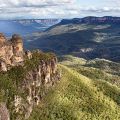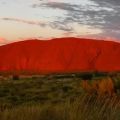What makes The Blue Mountains World Heritage Listed?

Sublime natural bounty and vast eucalypt woods set the stage over an expanse of over 1.3 million hectares. An amalgam of woodsy hillocks and deep gorges, sandstone cliffs and tunnelling caves to sprawling open woodlands and mallee scrublands, this natural wonder is a live amphitheatre of native flora and fauna! Welcome to the Blue Mountains! Millions all over the world have embarked on the trip to Blue Mountains on a sightseeing day tour, pulled to it by the ancient mysteries that go with this iconic landmark.
As with all World Heritage listings, this one was sure to make the cut, owing to not one but many reasons! Blue Mountains’ unique display of outstanding natural wealth and globally valuable environment is what favoured it foremost in finding a spot in this worldwide-acclaimed listing. Its rich woodlands, rainforests and heathlands are home to a diverse array of distinctive flora and fauna! To add to that, Blue Mountains also houses one of world’s most distinct and conserved scleromorphic forests (vegetation with stiff leaves and thickened epidermis) in the Earth’s temperate region!
Dating back to more than 50 million years, Blue Mountains reserves 10% of Australia's large trees, the king of the region being the eucalyptus! Blue Mountains houses 13% of the world’s total eucalypt diversity which extend to over100 classes – the best concentration in the world too! Out of these too, 12 of the 100 exist solely in this area. The characteristic blue tone of the Blue Mountains when seen from afar is also caused due to a refraction game between the sun and eucalyptus mist.
Apart from eucalyptus forests, Blue Mountains also encloses about 10% of Australia’s vascular flora. This vast region has over 127 categories of rare flora and fifty two species of endangered animal life. In all, over four hundred entirely different animal species inhabit the depths of its wilds, right from tiger quoll, yellow-bellied glider, koala, brush-tailed rock wallaby, broad-headed snake and regent honeyeater to the golden bell frog. The region is additionally home to Wollemi pine – a rare living fossil that goes back to the Mesozoic Era! It’s no wonder why conservation is a top priority when we talk of the Blue Mountains.
Add to it a rich legacy of Aboriginal historical connections, and up goes its significance! Numerous recorded sites supply proof of Aboriginal and Torres Strait dweller tribe inhabitations in the region, with some of it as old as 22000 years!
Its rich diversity and culture and wildlife withstanding, being a World Heritage is just the best thing to happen to this nature trove. Its World Heritage status offers a global accredit to the realm, second to none. Boosting world tourism and contributing to the growth in tourist revenue, it additionally aids the essential task of preserving this distinctive ecosystem for the long run. The funds that the region gets from the UN body topped by qualified suggestions and technological aids to implement preservation measures are sure to play a major role in retaining its diverse cultural and natural heritage.
A Blue Mountains day tour is just what it takes for everyone to realize its significance, with no doubts left on why it's a World Heritage Listed site. Visit, contribute to its conservation and revel in the scenic wonder that is Blue Mountains on a full day tour!
Other articles and publications:
- +1 (612) 829-6736
- 32 The Promenade, King Street Wharf, https://www. tourchief. com/







